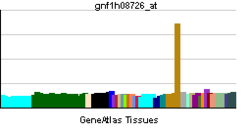- DEFB127
-
Defensin, beta 127 Identifiers Symbols DEFB127; C20orf73; DEF-27; DEFB-27; DEFB27; bA530N10.2; hBD-27 External IDs HomoloGene: 89142 GeneCards: DEFB127 Gene Gene Ontology Cellular component • cellular_component
• extracellular regionBiological process • defense response to bacterium
• innate immune responseSources: Amigo / QuickGO RNA expression pattern 
More reference expression data Orthologs Species Human Mouse Entrez 140850 n/a Ensembl ENSG00000088782 n/a UniProt Q9H1M4 n/a RefSeq (mRNA) NM_139074 n/a RefSeq (protein) NP_620713 n/a Location (UCSC) Chr 20:
0.14 – 0.14 Mbn/a PubMed search [1] n/a Beta-defensin 127 is a protein that in humans is encoded by the DEFB127 gene.[1][2]
Defensins are cysteine-rich cationic polypeptides that are important in the immunologic response to invading microorganisms. The protein encoded by this gene is secreted and is a member of the beta defensin protein family. Beta defensin genes are found in several clusters throughout the genome, with this gene mapping to a cluster at 20p13.[2]
References
- ^ Schutte BC, Mitros JP, Bartlett JA, Walters JD, Jia HP, Welsh MJ, Casavant TL, McCray PB Jr (Feb 2002). "Discovery of five conserved beta -defensin gene clusters using a computational search strategy". Proc Natl Acad Sci U S A 99 (4): 2129–33. doi:10.1073/pnas.042692699. PMC 122330. PMID 11854508. http://www.pubmedcentral.nih.gov/articlerender.fcgi?tool=pmcentrez&artid=122330.
- ^ a b "Entrez Gene: DEFB127 defensin, beta 127". http://www.ncbi.nlm.nih.gov/sites/entrez?Db=gene&Cmd=ShowDetailView&TermToSearch=140850.
Further reading
- van Wetering S, Sterk PJ, Rabe KF, Hiemstra PS (2000). "Defensins: key players or bystanders in infection, injury, and repair in the lung?". J. Allergy Clin. Immunol. 104 (6): 1131–8. doi:10.1016/S0091-6749(99)70004-7. PMID 10588992.
- Gerhard DS, Wagner L, Feingold EA, et al. (2004). "The status, quality, and expansion of the NIH full-length cDNA project: the Mammalian Gene Collection (MGC).". Genome Res. 14 (10B): 2121–7. doi:10.1101/gr.2596504. PMC 528928. PMID 15489334. http://www.pubmedcentral.nih.gov/articlerender.fcgi?tool=pmcentrez&artid=528928.
- Zhang Z, Henzel WJ (2005). "Signal peptide prediction based on analysis of experimentally verified cleavage sites.". Protein Sci. 13 (10): 2819–24. doi:10.1110/ps.04682504. PMC 2286551. PMID 15340161. http://www.pubmedcentral.nih.gov/articlerender.fcgi?tool=pmcentrez&artid=2286551.
- Clark HF, Gurney AL, Abaya E, et al. (2003). "The secreted protein discovery initiative (SPDI), a large-scale effort to identify novel human secreted and transmembrane proteins: a bioinformatics assessment.". Genome Res. 13 (10): 2265–70. doi:10.1101/gr.1293003. PMC 403697. PMID 12975309. http://www.pubmedcentral.nih.gov/articlerender.fcgi?tool=pmcentrez&artid=403697.
- Rodríguez-Jiménez FJ, Krause A, Schulz S, et al. (2003). "Distribution of new human beta-defensin genes clustered on chromosome 20 in functionally different segments of epididymis.". Genomics 81 (2): 175–83. doi:10.1016/S0888-7543(02)00034-4. PMID 12620395.
- Strausberg RL, Feingold EA, Grouse LH, et al. (2003). "Generation and initial analysis of more than 15,000 full-length human and mouse cDNA sequences.". Proc. Natl. Acad. Sci. U.S.A. 99 (26): 16899–903. doi:10.1073/pnas.242603899. PMC 139241. PMID 12477932. http://www.pubmedcentral.nih.gov/articlerender.fcgi?tool=pmcentrez&artid=139241.
- Deloukas P, Matthews LH, Ashurst J, et al. (2002). "The DNA sequence and comparative analysis of human chromosome 20.". Nature 414 (6866): 865–71. doi:10.1038/414865a. PMID 11780052.
Categories:- Human proteins
- Chromosome 20 gene stubs
Wikimedia Foundation. 2010.
